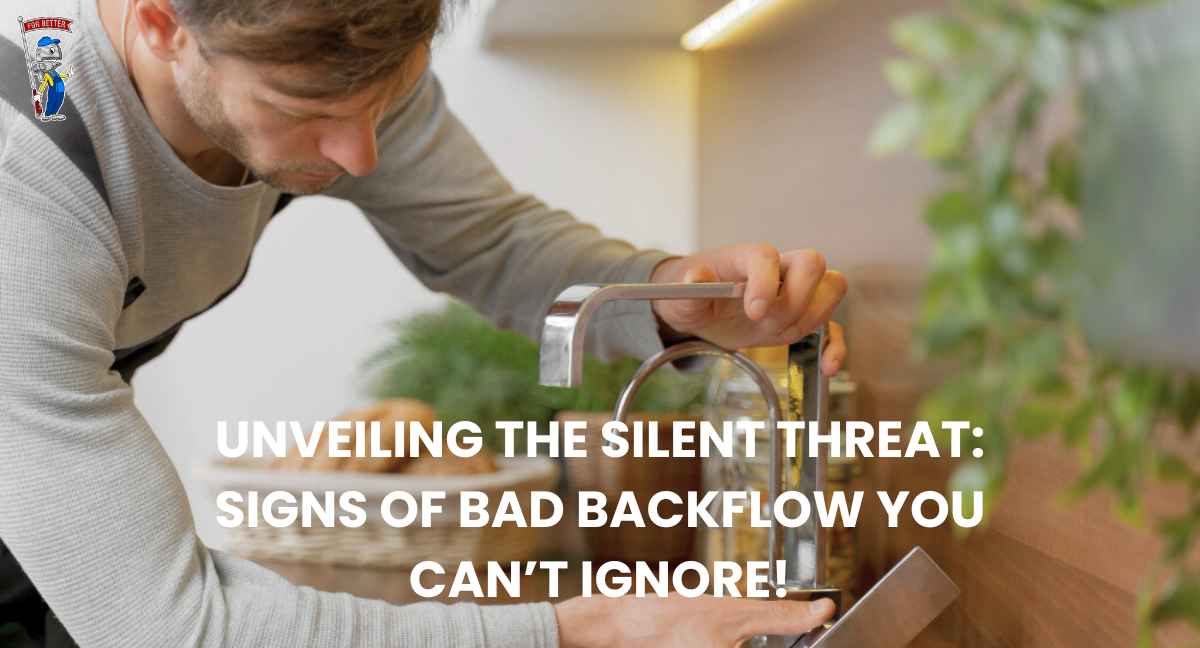Common Signs of Bad Backflow
Ever had your water flow the wrong way in your plumbing? That’s what we call backflow, and it can cause some serious problems, like health risks and damage to your plumbing. Knowing the signs of bad backflow is essential to catch it early and stop it from wreaking havoc on your home or business. Let’s break down the common signs you should look out for:
1.) Water Pressure Takes a Dive
First off, if you suddenly feel like your faucets or showerheads aren’t pushing out water like they used to, that’s a sign of bad backflow. It happens when water doesn’t flow the way it should. Catching this early can save you from more significant issues later on.
2.) Weird Smells in Your Tap Water
Another clear sign of backflow is when your tap water starts to smell funky. If it’s not the usual clean water smell, something might be off. Investigate it ASAP because ignoring strange odors could mean you’re risking your health by consuming contaminated water.
3.) Water Changes Color
Imagine turning on your tap, and instead of clear water, you see something brown or rust-colored. That’s a definite sign of potential backflow problems. It happens when stuff that shouldn’t be in your water gets in there. If your water changes color, don’t wait – get it checked out to prevent more issues with your plumbing.
4.) Odd Noises in Your Pipes
If you’re hearing weird sounds, like gurgling or bubbling, coming from your pipes, that could be a signal of bad backflow. These noises happen when air gets stuck in the pipes because the water flow is messed up. Consistent strange sounds mean it’s time to call in a professional plumber. Fixing the issue early can save you from bigger headaches later on.
Don’t worry; our experts are just a call away to guide you through the process. Contact Us now!
Unraveling the Causes Behind the Bad Backflow
Now, we’ll explore the underlying causes of bad backflow.
1.) Cross-Connections Gone Awry:
One of the primary culprits behind backflow is the mishandling of cross-connections. These are points in the plumbing system where potable (clean) water intersects with non-potable (contaminated) water. If the pressure on the non-potable side surpasses that of the potable side, backflow can occur, leading to an unwelcome mix of water streams.
2.) Drops in Water Pressure:
A sudden drop in water pressure can create a vacuum within the pipes, pulling water from unintended sources back into the system. This can happen due to main water line breaks, excessive demand on the municipal water supply, or even during firefighting efforts that strain the water infrastructure.
3.) Backsiphonage in Action:
Picture this: your toilet flushes, creating a surge in water demand. Simultaneously, the municipal water supply experiences a dip in pressure. This perfect storm can result in back siphonage, where water from the toilet bowl is drawn back into the main water supply. The result? A cocktail of contaminants making their way into your home’s water system.
4.) Faulty Check Valves:
Check valves are the gatekeepers of your plumbing system, designed to ensure water flows in one direction only. When these valves malfunction or fail, they open the door to potential backflow issues. Regular maintenance and inspection of these critical components can prevent such breaches.
5.) High Water Demand in Commercial Settings:
Businesses with substantial water needs, such as restaurants or industrial facilities, face unique challenges. The high water demand, coupled with intricate plumbing setups, can elevate the risk of backflow events if not properly managed.
6.) Improperly Installed Backflow Prevention Devices:
Ironically, the very devices designed to prevent backflow can be part of the problem if not installed or maintained correctly. Regular checks and professional installations are crucial to ensuring these devices function as intended.
Understanding these causes is the first step towards safeguarding your plumbing system from the woes of bad backflow. Stay vigilant, invest in preventive measures, and enjoy a consistently clean and safe water supply in your home or business.
How Neglecting Bad Backflow Turns into a Serious Problem
In the intricate tapestry of household concerns, the issue of bad backflow might seem like a minor inconvenience at first. However, dismissing or neglecting this seemingly small glitch in your plumbing system can quickly transform it into a serious and potentially costly problem. Let’s delve into the reasons why keeping an eye on bad backflow is crucial before it spirals out of control.
Water Contamination Woes
Unchecked bad backflow opens the door to water contamination. This means that the clean water you rely on for daily activities, from cooking to bathing, may become tainted with harmful substances. The health risks associated with contaminated water make it imperative to address bad backflow promptly.
Compromised Water Quality
As bad backflow persists, the overall quality of your water supply deteriorates. Sediments, chemicals, and other contaminants can infiltrate your plumbing system, leading to unpleasant odors, discoloration, and an overall compromised water experience.
Health Hazards in the Home
The contaminated water resulting from bad backflow poses a direct threat to the health of everyone in your household. Exposure to harmful substances can lead to a range of health issues, from stomach upsets to more severe conditions. Safeguarding your family’s well-being starts with addressing backflow concerns promptly.
Structural Damage to Property
Beyond health concerns, bad backflow can wreak havoc on your property. Continuous exposure to contaminated water can damage pipes, fixtures, and even the foundation of your home. The repair costs associated with structural damage can escalate rapidly, turning what started as a minor issue into a substantial financial burden.
Legal Compliance Matters
In many jurisdictions, there are regulations in place to ensure the safety and quality of water systems. Neglecting bad backflow can lead to non-compliance with these regulations, resulting in fines and legal consequences. Staying proactive in addressing plumbing issues is not just about your well-being but also about meeting legal standards.
Essential Strategies to Prevent Bad Backflow
Discover practical steps to shield your plumbing from the menace of bad backflow. These expert-recommended tips will empower you to fortify your home’s water system, ensuring a continuous flow of clean water.
Household Awareness
Equip every member of your household with the know-how to protect your plumbing. Educate them on the risks associated with backflow and the crucial role they play in reporting any plumbing irregularities promptly. A knowledgeable household is a key contributor to the collective prevention effort.
Pressure Monitoring: Keeping a Watchful Eye on Flow Dynamics
Maintain a vigilant watch on water pressure levels throughout your plumbing system. Sudden pressure drops can trigger back siphonage. Investigate promptly or consult with a seasoned plumber if you detect any unexpected changes in pressure.
Professional Consultation: Plumbing Wisdom from Experts
When uncertainties arise, seek the guidance of a professional plumber. A seasoned plumber can conduct a comprehensive evaluation of your plumbing infrastructure, pinpoint potential backflow risks, and prescribe customized preventive measures.
Arm yourself with these tried-and-true preventive strategies to thwart bad backflow. A proactive approach ensures the perpetual safety and purity of your home’s water supply. Call us now at Fairfax +1 (703)-250-4200, Arlington +1 (703)-524-1250 to book your consultation.
FAQs (Frequently Asked Questions)
How can I detect bad backflow at home?
Look out for signs like reduced water pressure, unusual odors, discolored water, or strange sounds in your plumbing.
What is backflow, and why is it a concern for homeowners?
Backflow occurs when the normal direction of water flow in a plumbing system is reversed, potentially bringing contaminants into the clean water supply. This is a significant concern for homeowners as it poses health risks, compromises water quality, and can lead to structural damage if left unaddressed.
Are there health risks associated with bad backflow, and how can they be mitigated?
Yes, bad backflow poses health risks as it can introduce contaminants into the water supply. To mitigate these risks, it’s essential to address backflow issues promptly, invest in backflow prevention devices, and educate household members about the potential dangers of contaminated water.
How often should I schedule plumbing inspections to prevent bad backflow?
Regular plumbing inspections are recommended at least once a year to proactively identify and address any potential backflow risks. Timely inspections can help homeowners stay ahead of plumbing issues, ensuring the continued safety and efficiency of their water supply.
Can bad backflow lead to structural damage in my home?
Yes, prolonged exposure to contaminated water due to bad backflow can result in structural damage. It is crucial to address backflow issues promptly to prevent damage to pipes, fixtures, and even the foundation of the home, saving homeowners from costly repairs.
How can I choose the right backflow prevention device for my home?
Choosing the right backflow prevention device involves considering factors such as the type of cross-connections in your plumbing system, local regulations, and the specific needs of your household. Consulting with a professional plumber can provide tailored advice on selecting the most suitable device for your home.
Conclusion
What may appear as a minor inconvenience can snowball into a serious problem when it comes to bad backflow. Regular inspections, prompt repairs, and investing in preventive measures are essential steps in ensuring the longevity of your plumbing system and the well-being of your home and its occupants. Don’t let a small issue become a big headache – address bad backflow with the seriousness it deserves.



